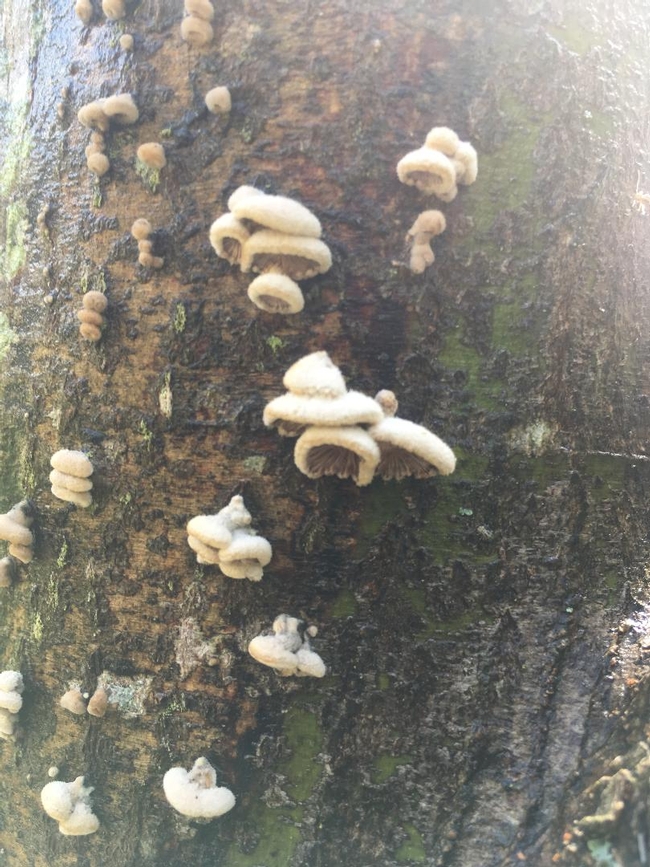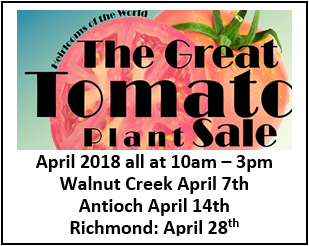Help!! My Japanese Maple is Dying Back!!
Advice for the Home Gardener from the Help Desk of the
UC Master Gardener Program of Contra Costa County
Client's Request: My 20 year old Japanese maple (Acer spp) did not return this year. I need help identifying what the problem is and how to resolve it. Pictures below show mushroom looking things growing on the tree. Not sure if it's the cause of the dieback. Thank you in advance!

MGCC Help Desk Response: As you have already recognized, the presence of the mushrooms on the trunk of your Japanese Maple tree is not a good development. It indicates that a fungus has somehow entered the tree. Typically, such fungi enter a tree's system either through the roots or through a wound on the tree or its roots. Wounds can be caused by such things as a nick by a lawn mower or “weed eater” cutter, excavations or poor pruning practices. Fungi can also enter the tree if a “root rot” disease develops. Once the fungus has entered the tree's interior tissue, it breaks down wood fibers, releasing nutrients needed to feed the fungus. After mushrooms become visible, the attack is well underway, and the fungus has begun reproducing through spores in or on the mushrooms.
When mushrooms are present on the main trunk of the tree as appears to be the case with your tree, there is not much hope that the tree can be saved. The breakdown of the tree's internal wood fibers to feed the fungus may weaken the tree structurally and if the problems has developed from a root rot problem, the roots may be weak and less able to support the tree. For these reasons, you may want to consider removing the tree.
Without knowing more about the history of your tree and the symptoms of earlier declines to the tree's health that may have been evident in prior growing seasons, we are unable to determine the precise cause of the decline of your tree. You may be able to learn more about the possible causes of the tree's decline at this University of California website: http://ipm.ucanr.edu/PMG/GARDEN/PLANTS/maple.html The website lists common disease problems that can affect Japanese Maple. We suggest that you look at the links for “root and crown rot” and for “wood decay” and consider whether they describe earlier signs or symptoms of a problem that you may have noticed in past growing seasons.
The abundance of pale, honey colored mushrooms shown in your photos suggest another possible fungal root disease not mentioned on the UC website referenced above. A fungus known as Armillaria mellea is the cause of Armillaria root rot. Early symptoms you might have observed if this fungi is the cause of the problem include reduced growth, yellowish leaves and dieback of twigs and branches. The development of the pale colored mushrooms around the base of the tree or the surrounding ground is a later development in the progress of the disease. If you suspect this fungus might be the cause of the tree's decline, you may want to try to confirm the diagnosis by looking for the presence of white mycelial fans between the bark and the underlying sapwood of the tree. This UC website has additional information about Armillaria root rot and includes a photo showing the white mycelial fan structures that underlie the bark: http://ipm.ucanr.edu/PMG/GARDEN/PLANTS/DISEASES/armillariartrot.html
Keep in mind that if the source of the fungal disease was in your soil, the fungal spores may remain in the soil and could potentially affect the roots of a replacement soil. For this reason, it would be a good idea to try to determine what disease was present in your tree. You might want to consider hiring an arborist to examine the tree and confirm what caused the problem. The arborist might also be able to provide a crew to remove the tree and give you some guidance on steps to take to avoid having a replacement tree develop the same problems. Here is a link to the International Society of Arboriculture (ISA) website. It has a search feature that allows you to find a certified arborist based on where you live. https://www.treesaregood.org/findanarborist
I hope that you find this information to be helpful. Please contact us again if you have further questions.
UC Master Gardener Program of Contra Costa County (tkl)
Note: The UC Master Gardeners Program of Contra Costa's Help Desk is available year-round to answer our gardening questions. Except for a few holidays, we're open every week, Monday through Thursday for walk-ins from 9:00 am to Noon at 75 Santa Barbara Road, 2d Floor, Pleasant Hill, CA 94523, although we will be moving this spring. We will notify you if/when that occurs. We can also be reached via telephone: (925)646-6586, email: ccmg@ucanr.edu, or on the web at http://ccmg.ucanr.edu/Ask_Us/ MGCC Blogs can be found at http://ccmg.ucanr.edu/HortCoCo/ You can also subscribe to the Blog (//ucanr.edu/blogs/CCMGBlog/)








